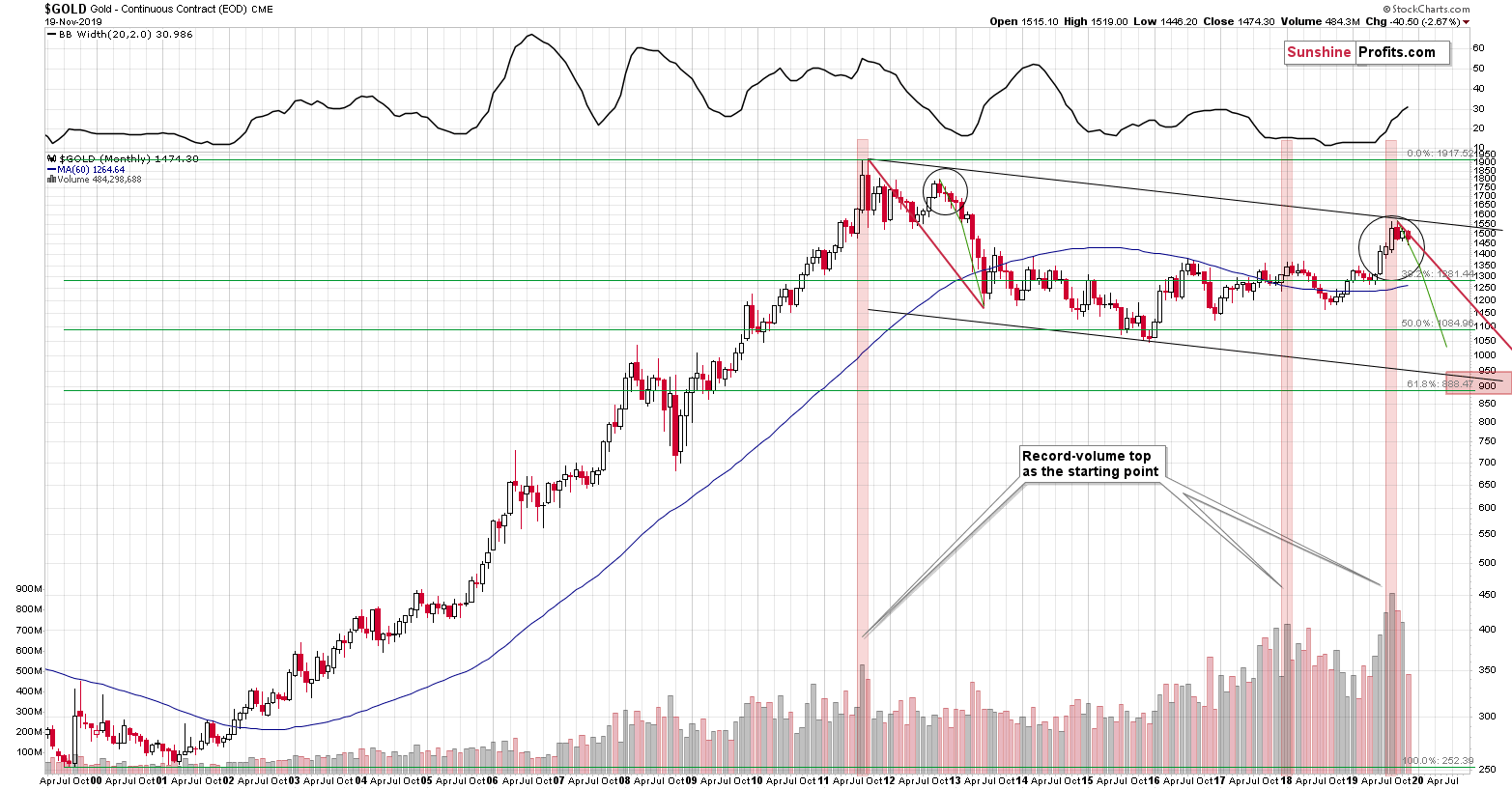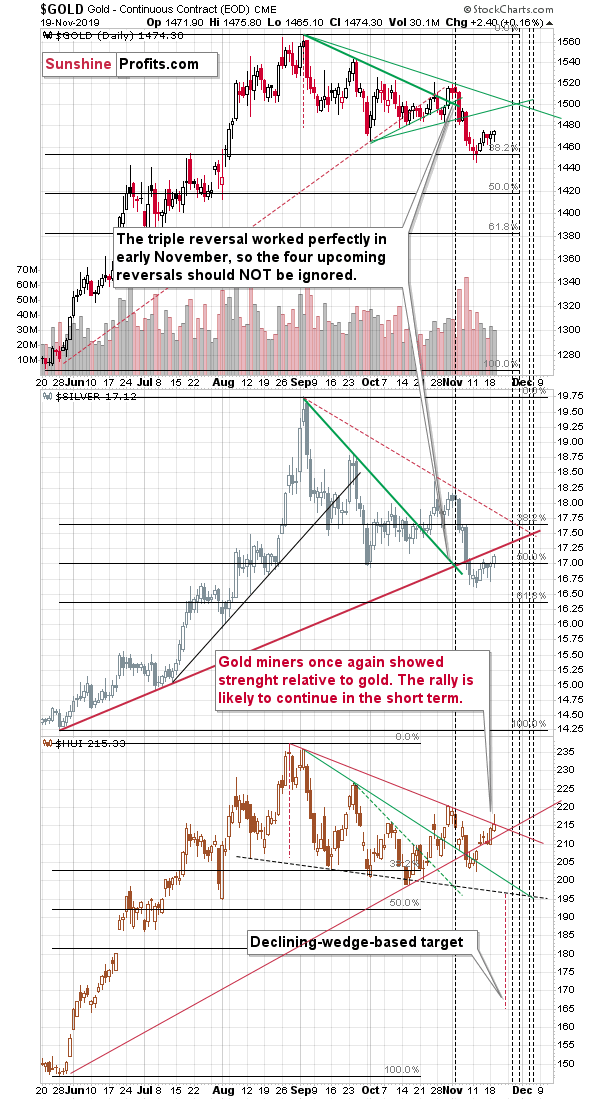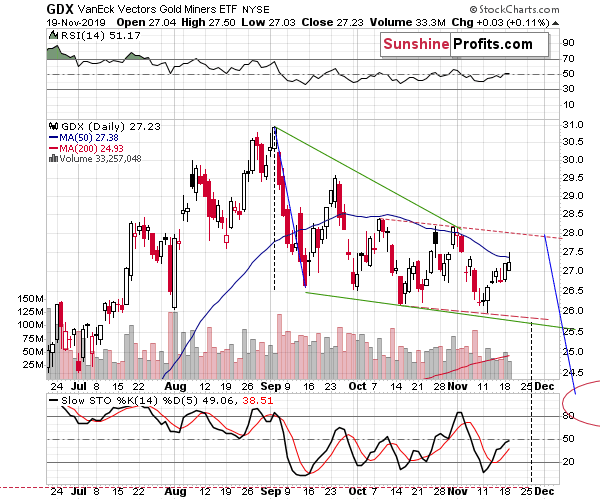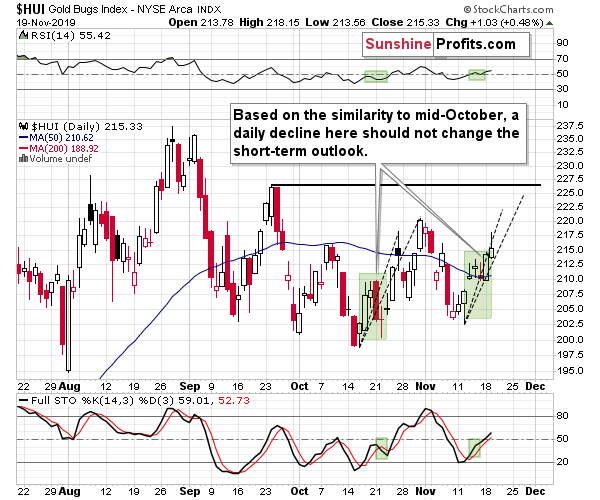Briefly: in our opinion, small (50% of the regular size of the position) speculative long positions in gold, silver, and mining stocks are justified from the risk/reward point of view at the moment of publishing this Alert.
We started the last few analyses with the micro point of view in which we explained why gold is likely to rally in the short term. Therefore, balance requires an overview of what's really going on in case of the medium-term trends. Instead of introducing you to quite a few relevant trees, let's take a look at the whole forest.
Gold Long-Term
The big picture shows one crucial thing. Gold has most likely formed a key 2019 top in August. The confirmation comes from the shape of the preceding upswing and the volume of the final monthly rally. Record-breaking volume shows that the investors' emotions got to the red-hot status and yet they were overwhelmed by the sellers.
There were only two cases when the monthly volume that we saw after a sizable upswing was similarly big, and it was at the 2011 and 2018 tops. Both were followed by substantial declines (in case of the former top, the above is an understatement), and since history tends to repeat itself, gold is likely to decline in the following weeks once again.
Please note that it's not just the similarity to the two above-mentioned cases that makes the medium-term outlook bearish. It's the way the volume works and it literally speaks volumes. It's not an out-of-the-blue analogy - investors' emotions are supposed to get red-hot at the major tops and the volume confirmed that this has indeed happened.
When people wonder how do I buy gold, they often end up buying something else than gold, but with - seemingly - analogous potential. Gold stocks. After all, the latter are less bulky to purchase and the transaction is often just several clicks away. Gold needs to be stored in a safe place, and so on. Don't get us wrong - we think that physical gold ownership has many merits, but we want to emphasize that many people choose to ignore them and go with the easier way of being in the precious metals market, as its - well - easier.
Consequently, when discussing gold's big picture, it's a great idea to supplement the yellow metal's analysis with the one of the mining stocks. In case of the long-term point of view, it's particularly interesting to see how mining stocks perform relative to other stocks. Thanks to this approach, we can isolate the moves in gold stocks that don't depend on the entire general stocks market.
That's valuable, because in this way we can avoid falling into the "tide lifts all boats" analytical trap. The factors that cause all stocks (including mining stocks) to move higher or lower will be taken out of the picture once we look at mining stocks through their ratio to other stocks. Consequently, let's take a look at the HUI to S&P 500 ratio.
As gold topped in August, the ratio topped as well, but while gold's top formed close to the late-2011 and mid-2012 lows (in terms of the weekly and monthly closing prices), the ratio formed at a level that's much more important from the long-term point of view. The ratio topped at its 1999 top.
That's a major top not only because of how clear it is. It's so important, because it was the final top before the previous multi-year bear market in the precious metals ended. The PMs then declined for about a year and the final bottom that formed, started a multi-year rally.
Just because the ratio is moving lower from the same level doesn't mean that it absolutely has to move in the same way, but there are multiple indications that point to this outcome anyway, so the above serves as a good confirmation. Besides, that's not the only bearish thing about the above chart.
The interesting thing about the 1999 top is that it already worked as support two times. It stopped (for a while, but still) the decline in late 2014 and it triggered a rebound in late 2015. The decline in the ratio resumed only after the ratio moved below the 1999 top. This year's top was actually the first time when this level served as resistance. This suggests that a bigger move lower is indeed likely just around the corner.
Speaking of resistances that have been useful and triggered a decline recently, there's also the 50-month moving average. It served as resistance in 2001, as support in 2005, 2006, and 2007. It served as resistance in 2012 and 2016. And it served as resistance this year as the ratio turned lower after attempting to confirm the breakout above it.
Moreover, please note what the ratio did when the new bull market started - after the 2000 bottom it soared and then it continued to show strength for the next few years. In fact, the biggest part of the rally in the ratio took place in the first few years of the 2000 - 2011 upswing. And what did the ratio do recently?
It was barely up even though gold rallied visibly, and it failed to take out the above-mentioned resistance levels. What's even more striking is that the recent rally in the ratio was much smaller than the ratio that we saw in 2016. The strength that we saw in the gold miners to other stocks ratio at the beginning of the previous bull market was definitely not present this year. Consequently, it's very unlikely that we saw a start of a new powerful, long-term rally in the ratio and in the rest of the precious metals sector.
Based on the above, the odds are that the decline will now continue, and since this ratio moves in tune with gold over the long run, it supports the bearish outlook for gold in the medium term. Consequently, while gold's rally continues in the short run, it's decline continues in the medium term.
We took profits from our previous short position and entered a long position right after the November 12 reversal. In the full version of this analysis, we outline the prices at which we are going to take profits from the long position and likely enter another short position. We're also discussing when that's (approximately) likely to take place. We encourage you to join our subscribers and profit along with us. Subscribe today.
Having said that, let's take a look at the short-term side of the precious metals market.
Short-Term Check on PMs
The entire sector moved higher yesterday, and it's worth noting that silver is now clearly above its late-September low. The rally in the white metal was not very impressive so far, but the clear invalidation of the breakdown below the September low is important.
The next resistance for silver is the rising red resistance line. Knowing silver's tendency to fake out instead of breaking out, it could be the case that silver soars above the red line in a convincing manner and tops shortly thereafter, once again tricking those who are new to this market and not paying attention to details.
The thing that might be concerning is the shape of yesterday's candlestick in the miners. The latter reversed, which might indicate an upcoming short-term decline. There's one important thing that's missing from this bearish picture.
The volume confirmation.
The volume on which GDX reversed yesterday was small, which means that there was no fierce battle between the buyers and sellers and that it was simply a "meh" day, where the price action was relatively inconclusive. We can't say that it was a tiny-volume upswing, because there was barely any upswing to speak of. The 3-cent move in terms of the closing price changes is more of a pause than a move.
Besides, miners are moving in perfect tune with how they rallied in the second half of October. Yesterday's close was practically right at the upper one of the dashed lines that are based on how the HUI increased in value last month.
Most interestingly, yesterday's action in gold and the USD Index precisely confirmed what we wrote about the link between them.
USD Index Update
Let's quote from our yesterday's analysis:
Now, since the USD Index already moved to our target area, there comes the question of whether this is likely to translate into a top in gold or not. Our answer is that it indicates that the top is relatively close, but not necessarily in yet.
You see, the link between gold and the USD Index is not as straightforward at it may appear at first sight. People will usually expect gold to move higher on the same day when the USD Index moves lower and vice-versa. And it quite often happens in this way. However, the strength of reaction varies. In fact, it could vary so much that moves in the USDX are going to be mostly ignored once the day-to-day price noise is filtered out.
In today's Alert, we will focus on the very specific part of the gold-USD dynamics - on gold's behavior during USD's consolidations. And more precisely, what happens if the USD Index continues to move sideways for a while and soars only after some time.
After all, that's exactly what could happen right now. The USD Index has already moved to our target area, but it doesn't automatically mean that the next upswing has to start immediately. In fact, pauses before rallies were quite common in the previous months. We marked those cases with green rectangles.
There were four similar cases this year. In two cases, the USDX consolidated after rallying and in two cases, it consolidated after declining. And yet, as far as the consolidation itself is concerned, we see the same kind of reaction in gold in all four of them.
Gold rallied most visibly when the consolidation in the USD Index was ending.
This is profound, because it means that the USD Index doesn't have to slide from here for gold to move higher in the next several days. The USD Index might move back and forth (perhaps slightly higher or slightly lower) and gold could form the final short-term pop-up just like it did in mid-April, mid-July, late-September, and late-October. In other words, our USD Index analysis doesn't invalidate our gold analysis.
Of course, if the USD Index declines some more, then gold would likely rally anyway.
That's the outlook for the short term and the short term only. After it's all said and done and the dust settles, the USDX is likely to resume it's medium- and long-term trends.
Indeed, the USDX didn't have to decline for gold to rally. Gold moved a bit higher yesterday and the same thing happened in the dollar. At the moment of writing these words, this subtle sign is being confirmed - gold is up by $3, while the USD Index is up by 0.10.
It seems that the USD Index is forming a broad bottom, similarly to what it did in July, September, and October, and gold is likely to rise slowly as it happens, and then pop up higher at the very end of its rally and USD's bottom. The history is likely to repeat itself and we are likely to get a good exit price on our profitable long positions and a good entry price for the upcoming short positions. Naturally, we'll keep you - our subscribers - informed.
Also, the key bearish factors for the medium term remain intact - the outlook is bullish only for the short term.
Key Factors to Keep in Mind
Critical factors:
- The USD Index broke above the very long-term resistance line and verified the breakout above it. Its huge upswing is already underway.
- The USD's long-term upswing is an extremely important and bearish factor for gold. There were only two similar cases in the past few decades, when USD Index was starting profound, long-term bull markets, and they were both accompanied by huge declines in gold and the rest of the precious metals market
- Out of these two similar cases, only one is very similar - the case when gold topped in February 1996. The similarity extends beyond gold's about a yearly delay in reaction to the USD's rally. Also the shape of gold price moves prior to the 1996 high and what we saw in the last couple of years is very similar, which confirm the analysis of the gold-USD link and the above-mentioned implications of USD Index's long-term breakout.
- The similarity between now and 1996 extends to silver and mining stocks - in other words, it goes beyond USD, gold-USD link, and gold itself. The white metal and its miners appear to be in a similar position as well, and the implications are particularly bearish for the miners. After their 1996 top, they erased more than 2/3rds of their prices.
- Many investors got excited by the gold-is-soaring theme in the last few months, but looking beyond the short-term moves, reveals that most of the precious metals sector didn't show substantial strength that would be really visible from the long-term perspective. Gold doesn't appear to be starting a new bull market here, but rather to be an exception from the rule.
- Gold stocks appear to be repeating their performance from 20 years ago, which means that a bottom in the entire precious metals sector is quite likely to form at much lower prices, in about a year
Very important, but not as critical factors:
- Long-term technical signs for silver, i.a. the analogy in terms of price to what we saw in 2008, shows that silver could slide even below $10.
- Silver's very long-term cycles point to a major reversal taking place right now and since the most recent move was up, the implications are bearish (this is also silver's technical sign, but it's so important that it deserves its own point)
- Long-term technical signs for gold stocks point to this not being a new gold bull market beginning. Among others, it's their long-term underperformance relative to gold that hint this is rather a corrective upswing within a bear market that is not over yet.
- Record-breaking weekly volume in gold is a strong sign pointing to lower gold prices
Important factors:
- Extreme volume reading in the SIL ETF (proxy for silver stocks) is an effective indication that lower values of silver miners are to be expected
- Silver's short-term outperformance of gold, and gold stocks' short-term underperformance of gold both confirm that the precious metals sector is topping here
- Gold topped almost right at its cyclical turning point, which makes the trend reversal more likely
- Copper broke below its head-and-shoulders pattern and confirmed the breakdown. The last time we saw something similar was in April 2013, when the entire precious metals sector was on the verge of plunging lower.
Moreover, please note that while there may be a recession threat, it doesn't mean that gold has to rally immediately. Both: recession and gold's multi-year rally could be many months away - comparing what happened to bond yields in the 90s confirms that.
Summary
Summing up, the outlook for the precious metals sector remains very bearish for the following months (also because of the record open interest in gold), but it seems that we will first see a short-term upswing before the decline continues. Based on what we saw in the last few days, the bullish outlook remains justified. It seems that the profits on our long positions will become bigger before we close it. We expect to close the long position within the next 1-2 weeks, but it might happen sooner, for instance should we see a sharp rally and a reversal shortly. We plan to then open a short position shortly.
Speaking of profits, we rarely mention what's happening in our other premium products within other products, but this time it's really justified. The results are too good, not to tell you about them. Some time ago, we introduced Day Trading Signals, and we wrote that they were so profitable in our tests that we didn't want to tell you how good they were, but rather to show you in real time. Several months passed, we proved our point and Nadia took a break to fully prepare for the launch of the paid-for version. This service is now fully live and the trades' results are exceptional.
The above link features all trades, but please take a closer look at this month's performance: there were 15 trades so far and 11 of them were profitable. As the history shows, it's not an exception or a lucky shot, but a rule. Since the premium version of this service was launched very recently and we want to popularize it, there's a promotion that allows for subscribing for the first 3 weeks at the preferred rate of $9. The regular monthly price is also currently at a level that's very low ($99) compared to the value this service provides.
The services that work in similar ways tend to cost thousands of dollars, while not delivering accuracy that could match our Day Trading Signals' one. If making money on quick trades is something you're interested in, we strongly encourage you to consider subscription to our Day Trading Signals. There might be someone you know that's into this kind of trading and would like to see our performance - please don't hesitate to let them know. We unlocked all the past trade details, so everyone's free to check exactly what and when we delivered.
As always, we'll keep you - our subscribers - informed.
To summarize:
Trading capital (supplementary part of the portfolio; our opinion): Small speculative long position (50% of the full position) in gold, silver, and mining stocks is justified from the risk/reward perspective with the following stop-loss orders and binding exit profit-take price levels:
- Gold: profit-take exit price: $1,489.80; stop-loss: $1,437; initial target price for the UGLD ETN: $135.88; stop-loss for the UGLD ETN: $122.10
- Silver: profit-take exit price: $17.47; stop-loss: $16.27; initial target price for the USLV ETN: $89.33; stop-loss for the USLV ETN: $72.44
- Mining stocks (price levels for the GDX ETF): profit-take exit price: $27.88; stop-loss: $25.47; initial target price for the NUGT ETF: $30.27; stop-loss for the NUGT ETF $23.08
In case one wants to bet on junior mining stocks' prices, here are the stop-loss details and target prices:
- GDXJ ETF: profit-take exit price: $39.27; stop-loss: $35.38
- JNUG ETF: profit-take exit price: $67.97; stop-loss: $49.83
Long-term capital (core part of the portfolio; our opinion): No positions (in other words: cash)
Insurance capital (core part of the portfolio; our opinion): Full position
Whether you already subscribed or not, we encourage you to find out how to make the most of our alerts and read our replies to the most common alert-and-gold-trading-related-questions.
Please note that the in the trading section we describe the situation for the day that the alert is posted. In other words, it we are writing about a speculative position, it means that it is up-to-date on the day it was posted. We are also featuring the initial target prices, so that you can decide whether keeping a position on a given day is something that is in tune with your approach (some moves are too small for medium-term traders and some might appear too big for day-traders).
Plus, you might want to read why our stop-loss orders are usually relatively far from the current price.
Please note that a full position doesn't mean using all of the capital for a given trade. You will find details on our thoughts on gold portfolio structuring in the Key Insights section on our website.
As a reminder - "initial target price" means exactly that - an "initial" one, it's not a price level at which we suggest closing positions. If this becomes the case (like it did in the previous trade) we will refer to these levels as levels of exit orders (exactly as we've done previously). Stop-loss levels, however, are naturally not "initial", but something that, in our opinion, might be entered as an order.
Since it is impossible to synchronize target prices and stop-loss levels for all the ETFs and ETNs with the main markets that we provide these levels for (gold, silver and mining stocks - the GDX ETF), the stop-loss levels and target prices for other ETNs and ETF (among other: UGLD, DGLD, USLV, DSLV, NUGT, DUST, JNUG, JDST) are provided as supplementary, and not as "final". This means that if a stop-loss or a target level is reached for any of the "additional instruments" (DGLD for instance), but not for the "main instrument" (gold in this case), we will view positions in both gold and DGLD as still open and the stop-loss for DGLD would have to be moved lower. On the other hand, if gold moves to a stop-loss level but DGLD doesn't, then we will view both positions (in gold and DGLD) as closed. In other words, since it's not possible to be 100% certain that each related instrument moves to a given level when the underlying instrument does, we can't provide levels that would be binding. The levels that we do provide are our best estimate of the levels that will correspond to the levels in the underlying assets, but it will be the underlying assets that one will need to focus on regarding the signs pointing to closing a given position or keeping it open. We might adjust the levels in the "additional instruments" without adjusting the levels in the "main instruments", which will simply mean that we have improved our estimation of these levels, not that we changed our outlook on the markets. We are already working on a tool that would update these levels on a daily basis for the most popular ETFs, ETNs and individual mining stocks.
Our preferred ways to invest in and to trade gold along with the reasoning can be found in the how to buy gold section. Additionally, our preferred ETFs and ETNs can be found in our Gold & Silver ETF Ranking.
As a reminder, Gold & Silver Trading Alerts are posted before or on each trading day (we usually post them before the opening bell, but we don't promise doing that each day). If there's anything urgent, we will send you an additional small alert before posting the main one.
Thank you.
Sincerely,
Przemyslaw Radomski, CFA
Editor-in-chief, Gold & Silver Fund Manager









